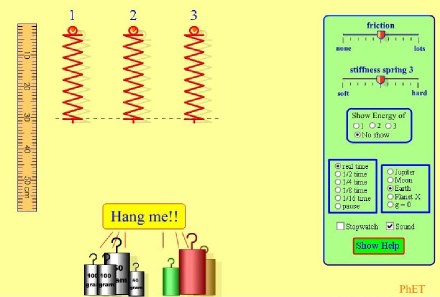
Teaching Physics with the Physics Suite
Edward F. Redish
Home | Action Research Kit| Sample Problems | Resources | Product Information
Problems Sorted by Type | Problems Sorted by Subject | Problems Sorted by Chapter in UP
 |
Teaching Physics with the Physics Suite Edward F. Redish Home | Action Research Kit| Sample Problems | Resources | Product Information |
Problems Sorted by Type | Problems Sorted by Subject | Problems Sorted by Chapter in UP |
The University of Colorado PhET group has produced a nice on-line simulation that lets you explore the force law and period of oscillation for a mass hung from a spring as well as how the energy is distributed. In this problem, you will explore some of the aspects the the mass-on-a-spring system. The mass-spring-lab is available online.
First explore the interface. It is shown at the right. Notice that you
can:
When adding and removing the masses, you might find it useful to pause the simulation by clicking on the "pause" radio button in the time box. You can start it up again by clicking on one of the "time" buttons. |
 |
A. The sliders for the friction and spring stiffness have no numbers marked on them. Determine what they mean by changing them and seeing how the motion of a hanging mass changes. Does the "0" marker (the leftmost mark on the slider) correspond to the value "0" for friction? for spring stiffness (k)? Explain how you decided.
B. Set the slider for "stiffness of spring 3" in the middle (at the "5" mark). When it is set this way, do all three springs have the same spring constant? Explain how you decided. Can you find the spring constants of each of the springs? If you can, find them. If you can't, explain why you can't. When you change the slide for "stiffness of the spring 3" to a different value, do all the springs change together? Explain how you d ecided.
C. There are three masses on the right of the mass collection colored red, gold, and green. These are not labeled as to their mass. Can you find their masses? If you can, do it. If you can't, explain why you can't.
D. Turn on the display of the energy of 3. Determine where on the screen for what configurations of the mass and spring it defines the zero of the gravitational potential energy and for what configurations of the mass and spring it defines the zero of the elastic (spring) potential energy.
E. For this part of the problem, you are to watch the pattern of the energies change as the mass and spring oscillates. First, set a mass on one of the springs. Turn on maximum friction and let the mass come to rest. Move the dotted line to show where the equilibrium point is. Now turn off friction and move the mass to another spring at just the equilibrium point so it remains almost at rest. (This will restart the energy calculation.) Turn on the view of energy for your system. You should have some elastic PE and some gravitational PE.
Not finding what you wanted? Check the Site Map for more information.
Page last modified March 29, 2008: O38